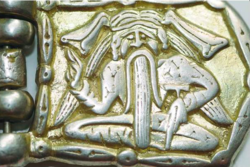
Back آثار الشامانية في الفولكلور المجري Arabic Венгр фольклорында шаманлыҡ ҡалдыҡтары Bashkir Sámánság a magyarok között Hungarian Շամանիզմը հունգարական ֆոլկլորում Armenian Urme șamaniste în folclorul maghiar Romanian Пережитки шаманизма в венгерском фольклоре Russian Macar folklorunda Şamanistik kalıntılar Turkish Маҗар фольклорында шаманчылык калдыклары Tatar Пережитки шаманізму в угорському фольклорі Ukrainian
Hungarian shamanism is discovered through comparative methods in ethnology, designed to analyse and search ethnographic data of Hungarian folktales, songs, language, comparative cultures, and historical sources.

- ^ Attila Turk, HUNGARIAN ARCHAEOLOGY, The new archaeological research design for early hungarian history, 2012, p. 3
- ^ Türk Attila Antal: A szaltovói kultúrkör és a magyar őstörténet régészeti kutatása. In.: Középkortörténeti tanulmányok 6. A VI. Medievisztikai PhD-konferencia (Szeged, 2009. június 4-5.). szerk.: G. Tóth P. –Szabó P. Szeged (2010) 284–285, és 5. kép,
- ^ Bokij, N. M. – Pletnyova, Sz. A.: Nomád harcos család 10. századi sírjai az Ingul folyó völgyében. AÉ. 1989, 86–98.
© MMXXIII Rich X Search. We shall prevail. All rights reserved. Rich X Search